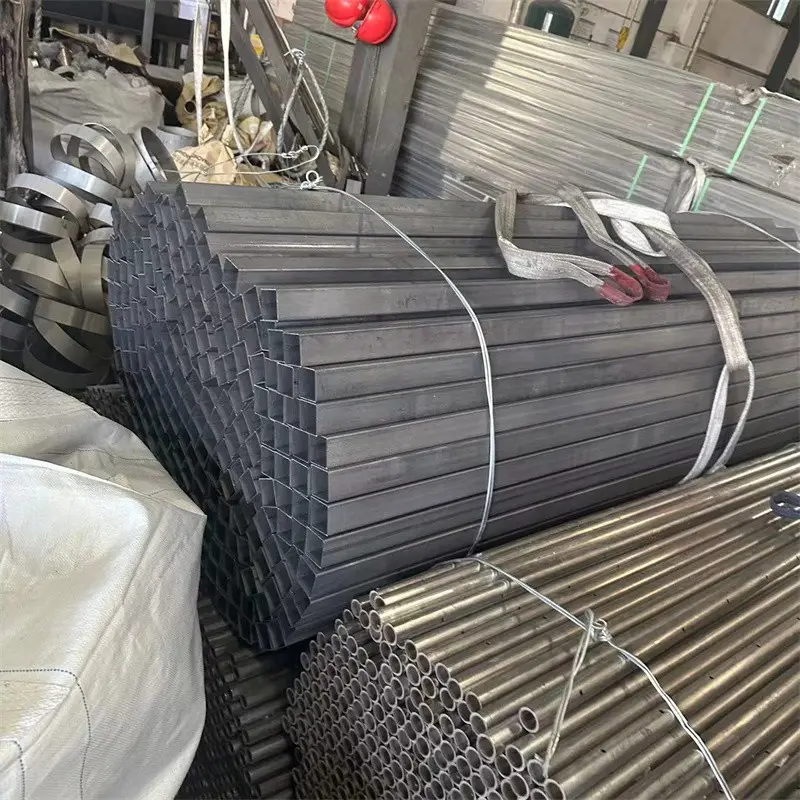הכרת דרגות פליז נержשת ומפרט החומר
דרגות פליז נержשת עיקריות (304 מול 316 מול 201)
חשוב להבין מהו הבדל בין דרגות הפליז האינוקס 304, 316 ו-201 בבחירת החומר הנכון ליישומים מסוימים. דרגה 304 נחשבת לאפשרות הנפוצה ביותר בתחומים רבים, הודות ליכולת שלה להתנגד לתחמוצות ולעמוד בטיפול ממושך. ניתן למצוא אותה במטבחים רבים, בהם יש חשיבות לחוזק ולעומד. דרגה 316 כוללת בתוכה מוליבדן, מה שמשנה את המצב במיוחד באזורים עם מי מלח, ולכן נוטים להשתמש בה במבנים ימיים ובachts. הבחירה הזולה יותר היא לרוב דרגה 201, מאחר שהיא מכילה פחות ניקל. לעתים קרובות בוחרים בה לייצור חלקים לאוטומובילים או למבנים בסיסיים, אך יש לזכור שהיא פחות עמידה בפני קורוזיה בהשוואה לשאר הדרגות.
לכל אחת מדרגות הصلב stainless steel אלו יש מאפיינים מכאניקליים ייחודיים שלהן, מה שעושה אותן מתאימות יותר למטרות מסוימות. לדוגמה, לפליז 304 יש חוזק מתיחה של כ-515 MPa, ולכן הוא מאוזן בין חוזק ויכולת לעיצוב, מה שמסביר למה הוא נפוץ כל כך בתעשייה. דרגה 316 אינה רחוקה מבחינת חוזק המתיחה אך מוסיפה גם קשיות, מה שעושה אותה טובה במיוחד לציוד עיבוד כימי. יש גם את דרגה 201, שבנויה בצורה שונה ומחזיקה טוב יחסית, אם כי לא כמו האחרות. כ правило משתמשים בזו כאשר אין צורך בפחתת מגן against קורוזיה, כמו חלקים מסוימים במבנים או ציוד דקורטיבי שבו המראה חשוב יותר מאריכות.
נתוני תעשייה תומכים בישום הפרקטי של חומרים אלו. פליז חמצן 304 נמצא בשימוש נרחב הן בבית והן במנחות. לאחר מכן קיים 316 שמתקנים כימיים ומרפאות רבים סולקים עליו באופן כבד לצורך השתלות ודברים אחרים בהם עמידות בפני קורוזיה היא חשובה ביותר. הדרגה 201 נוטה להופיע יותר בתעשיית הרכב לחלקים שאינם זקוקים לעוצמה רבה כל כך. רוב המקצוענים בתחום יאמרו לכל מי ששומע שדרגות אלו הפכו לסטנדרט pretty much בתעשייה השונות מכיוון שהן מתאימות כל כך למטרת השימוש שלהן.
השפעת הרכב החומר על עמידות בפני קורוזיה
מה שגורם לפליז חלוד להראות כה עמיד בפני חמצון נובע מהרכב שלו. מתכות שונות שמעורבבות בתплав משנה את היכולת שלו לעמוד בנזקי קורוזיה לאורך זמן. לכל הפליזים חלוד יש כרום, שיוצר שכבה דקה ובלתי נראית על פני השטח הנקראת חומרת כרום. השכבה הזו עוצרת למעשה את הגעת החמצן למתכת שמתחתיה, ומונעת את היווצרות החלה. דרגות כמו 304 ובעיקר 316 מכילות גם никל בכמויות גדולות יותר. никל הופך את המתכת לקלה לעיבוד בתהליך הייצור, וכן עוזר להגן מפני תגובות חמצון. דרגה 316 מוסיפה אלמנט נוסף לתערובת – מוליבדן. היסוד הנוסף הזה מעניק לה הגנה טובה בהרבה מפני חורצים טורדיים שיוצרים בתמיסה מלחית או בתנאי כימיה קשוחים. לכן, יצרני ציוד ימי מציינים לרוב את דרגה 316 עבור חלקים שנחשפים לתנאים קשים.
מספר רב של ניסויים ובדיקות בשטח תומכים במה שראינו בפועל בנוגע להשפעת הרכב החומרי על התנגדות לנזקי סביבה. קחו לדוגמה את הדרגה 316 – היא מפגינה ביצועים טובים בהרבה מחלופות אחרות כמו פליז חמצן 304 כאשר היא מועמדת לסביבות קורוזיביות שבהן מתרחשת בדרך כלל קורוזיה נקודתית או קורוזיה בפערים. מה הסיבה? פשוט stated, בדרגה 316 יש יסודות סגסוגת נוספים שמעניקים לה תכונות הגנה מתקדמות. מהנדסים המשמשים בפרויקטים הקשורים לסביבות כימיות אגרסיביות או חשיפה למים מלוחים מציינים לרוב את הדרגה 316, שכן חומרים אלו פשוט נמשכים לאורך זמן ללא דגראדציה. שילוב הכרום, הنيquel וה몰יבדן יוצר מחסום הגנה שמהווה את ההבדל המכריע בהפחתת אורך החיים של רכיבים בתנאי פעולה קשים.
בחינה של מה שקורה בפועל מציגה באמת למה בחירת הדרגה המתאימה של החומר חשובה כל כך למגוון מצבים. רבים מהתקלות בתעשייה חוזרים בפועל לבחירות שגויות בדרגת החומר שהובילו להבליית רכיבים הרבה לפני הזמן. קחו לדוגמה פליז חמצן דרגה 304 – אם ישתמשו בו קרוב למים מלוחים או בריכות כלור, הוא נוטה לפתח את החריצות המגעילות האלה עם הזמן. בדיוק בגלל זה, מהנדסים צריכים לחשוב על המקום שבו משהו יותקן לפני שהם בוחרים. המסקנה העיקרית מכל הנסיונות האלה? התאמה של החומר למה שהוא יתמודד איתו בחיים האמיתיים זה לא רק תרגול טוב, זה הכרח כדי להשיג את חיי השירות האופטימליים מכל ציוד.
הערכת דרישות היישום וסטנדרטים תעשייתיים
התאמת מפרט הצינורות לצרכים של הפרויקט
בחירת הדרגה הנכונה צינור נירוסטה מבחינה טכנית, התאמה של המפרט למה שהפרויקט דורש היא חיונית כדי שהדברים יעבדו כראוי וישמרו על הבטחה. מדידות מפתח כמו קוטר, עובי דופן ו рейיטינג של לחצים צריכות להתאים בדיוק למה שהמשימה דורשת. כשאין התאמה, בעיות נוצרות במהירות. היו לנו מקרים שבהם מפרט לא תקין הוביל לפיצול צינורות בזמן בדיקת לחץ במנעולים, מה שהוביל לדחיות גדולות ולבעיות בטחוניות. גם תנודות טמפרטורה חשובות. הרבה מהנדסים שוכחים מהסיכן של קורוזיה שמגיעה מהתרכובות הכימיות שעוברות במערכת לאורך הזמן. לכן, דפי המפרט של צינורות פליז מציינים תמיד את דרגת ההתנגדות הכימית. עבור מפעלים כימיים או פלטפורמות ימיות עם חשיפה למים מלוחים, קבלת הפרטים הנכונים זה לא רק תרגול טוב – זה הכרח מוחלט להמשך תקינות.
1. תכונות : התאם את צינורות הקוטר, עובי הדופן ורייטינג הלחץ לדרישות הפרויקט.
2. טמפרטורה וחשיפה כימית : שיקולים חיוניים לייחוסיות בתנאים קשים.
3. תקנים בתעשייה : תקנים בינלאומיים כמו ASTM ו-ASME מנחים את הבחירה.
שימוש בסטנדרטים ובمزומדים בתעשייה, כמו ASTM ו-ASME, הוא חיוני בתהליך הבחירה, ומבטיח שהצינורות עומדים בקריטריונים לה_quality ולתפקוד שנקבעו. סטנדרטים אלו מוכרים ברחבי העולם ומספקים הפניה לעמידה בדרישות אופרטיביות ובבטיחות.
עמידה באישורי איכות בינלאומיים
אישורי איכות כמו ISO 9001 מהווים תפקיד גדול כשמגיעים לסמוך על ספקים של צינורות פליז. מה שאישורים אלו באמת מציינים הוא שחברות עוקבות אחר תהליכי בקרת איכות מחמירים אשר עוזרים לשמור על אחידות של המוצרים בין משלוחים ומבטיחים ללקוחות לקבל את מה שמצפים בכל פעם. כשיצרנים עומדים בסטנדרטים אלו, רוכשים יודעים שהצינורות אמורים לפעול כראוי, בין אם יותקנו מתחת לאדמה בתנאים קשים או ייחשפו לטמפרטורות קיצוניות במרחב הפתוח. מוצרים השקט הנפשי שזה מעניק שווה כל מטבע עבור כל אחד שפועלים בפרויקטים קריטיים של תשתיות בהן כשלון אינו אופציה.
1. ISO 9001 : הבטחה לאיכות ואימנויות אחידות.
2. מערכות ניהול האיכות : מבטיחים אחידות במוצרים ושביעות רצון של הלקוחות.
3. דוגמאות מתעשייה : תחומים עם דרישות תפקודיות קריטיות, מציגים את הצורך בספקים מאושרים.
תעשייה שבה התאמה לסטנדרטים אלה היא קריטית כוללת תחומים הקשורים לתקני בטחה קפדניים, כמו תעשיית החלל, הרכב ועיבוד כימי. נתוני סקר מגלים העדפה בולטת לספקים אשר עוקבים אחר תקנים בינלאומיים לאיכות, מאחר שcertifications אלה מהווים לעיתים קרובות גורם הבחנה מרכזי בשוק.

הערכת יכולות הייצור והטכנולוגיה של הספק
שיטות ייצור מתקדמות במפעלים בסין
יצרני צינורות פלדה לא מדודה סינים משנים את הדרך שבה דברים עובדים במגזר שלהם באמצעות שיטות ייצור חדשות. יותר ויותר מפעלים מאמצים מערכות ריתוך אוטומטיות לצד טכנולוגיות עיבוד מתוחכמות. מה גורם לשינויים אלה חשובים? הם משפיעים על הכל, מה שמוצא מהבמה של המפעל, עד למהירות בה מוצרים מיוצרים וכמה הם עולים בסופו של דבר. כאשר רופפים אוטומטים את עבודתם, הם משיגים תוצאות טובות יותר באופן עקבי בין הסטות, מה שמפחית טעויות בזבוז חומר. באותו זמן, ציוד עיבוד מודרני נותן לצינורות את הממדים המדויקים ואת פני השטח חלקים הלקוחות רוצים. הסתכלות על דוגמאות אמיתיות מחברות ברחבי סין מראה עד כמה ההשפעה של השדרוגים האלה יכולה להיות. כמה מפעלים קיצצו את לוח הזמנים שלהם של הייצור כמעט בשליש לאחר יישום הטכנולוגיות האלה. בנוסף, מכיוון שמכונות מטפלות בכל כך הרבה משימות עכשיו, יש למעשה חסכונות בכל התהליך. זה אומר שחברות יכולות להעביר מחירים נמוכים יותר לקונים תוך שמירה על סטנדרטים גבוהים עבור המוצרים שלהן.
יכולת התאמה אישית והזמנת כמויות גדולות
בעבודה עם ספקים של צינורות פליז ממתכת, היכולת שלהם להתמודד עם הזמנות מותאמות ותהליך ייצור בכמויות גדולות עולה כממד קריטי. ספקים טובים מבינים את עניינם בתחום ההטמעה, ויכולים לספק גדלים, דרגות וסיימויות משטח התואמות את הדרישות של מגוון ענפים. פרויקטים בתחומי הבנייה והתשתית דורשים לרוב כמויות גדולות, ולכן היכולת להרחיב את תהליך הייצור היא חשובה ביותר. רוב הקונים בודקים דברים כמו גודל הזמנה מינימלי ולוחות זמנים למשלוח לפני קבלת החלטות. יצרנים שמשמרים גמישות נוטים להרבות בלקוחות שמרוצים, ומציגים את היכולת שלהם להתאים את עצמם במהירות לשינויים בתנאי השוק. לקוחות מרוצים רבים מציינים עד כמה ספקים אלו הם אמינים כשמטפלים גם בדרישות מיוחדות וגם בהזמנות בכמויות גדולות, מבלי לפגוע באיכות ובביצועים.
ניתוח הליכי ביקורת איכות ובוחנים
שיטות בחינה ללא הרס לצינורות פליז חלוד
שיטות בדיקה לא מזיקות הן חשובות כשמדובר בבדיקה של איכות צינורות פליז חלוד resistant בתהליכי ייצור. הגישות העיקריות שנמצאות בשימוש כיום כוללות דברים כמו בדיקות אולטראסאונד, רנטגן, וגילוי זרמי ערבוב. מה שמייחד את השיטות הללו הוא שהן בודקות את שלמות הצינורות מבלי לפגוע בחומר עצמו, מה שעובד מצוין גם כשמביטים בمنتجات לפני שעזבו את קו הייצור וגם לאחר ההתקנה. עמידה בדרישות התעשייה כמו אלו שנקבעו על ידי ASTM E94 ו-ASME V שומרת על תקן אחיד בכולל מתקנים שונים. לדוגמה, מפעלי תיבול נפט סומכים רבות על בדיקות אולטראסאונד כדי לאתר תקלות פוטנציאליות בשלבים מוקדמים, דבר שהציל literalamente מיליונים עבור חברות על ידי מניעת כשלים חמורות במערכות מיתן קריטיות.
דרישות אישור ליישומים תחת לחץ
תנאי האישור עבור צינורות פליז במערכות לחץ מהווים תפקיד חשוב בשמירה על הפעלה בטוחה ותפקודית. לרוב, יצרנים נדרשים לקבל חותמות לפי ASME וכן לעמוד בדרישות שונות של כלי אגרת לחץ. מדובר לא רק בexercise בירוקרטיה - אלא בדרישות אמיתיות שמונעות את הפעולה התקינה כאשר כשלונות עלולים להיות אסירים. ראינו לא מעט מצבים בהם חומרים באיכות נמוכה הובילה לפיצוץ צינורות ועצירת מערכות, מה שהעלה לחברות גם כסף וגם מוניטין. האישורים הנכונים בעצם אומרים למהנדסים שהצינורות יכולים לעמוד במה שנזרק עליהם בתנאים קשים. זה חשוב במיוחד בתעשייה כמו ייצור כימיקלים או פלטפורמות חופיות, שם אפילו דליפה קטנה יכולה להפוך לבעיה גדולה. קבלת האישורים הנכונים זה לא רק עניין של עמידה בכללים - אלא הגנה של אנשים וציוד מפני אסונות פוטנציאליות בדרכם.
השוואת מודלי מחירים והיבטים לוגיסטיים
גורמים כלכליים בייצור פסولات פליז חלוד
בשליטה על הגורמים לעלות הייצור של צינורות פליז מונעת עניין גדול לייצרנים וכן לקונים של המוצר. מספר גורמים מרכזיים קובעים את עלות הייצור של הצינורות. חומרים גלם כמו ניקל וכרום נקלטים בשווקים שלהם, אשר מחירים שלהם משתנים כל הזמן, מה שמImpact ישירות על עלויות הסופיות. שכר עבודה אינו אחיד גם הוא, והוא תלוי מאוד במיקום הייצור ובסוג הכוח אדם המומחה הנדרש בשלבים השונים. גם הדרישה מהשוק משפיעה על המחירים. כאשר יש ביקוש גבוה, המחירים נוטים לעלות, מה שמחייב את הקונים להתאים את תקציבי הרכישה שלהם. בחינה היסטורית מציגה כי מחירי פליז עלו קפיצה מספר פעמים בעשור האחרון בעקבות אותם גורמים. לכן קונים מושכלים מקפידים לעקוב אחרי תנאי השוק ולבנות גמישות באסטרטגיית הרכש שלהם. מחקר שוק איכותי מספק מידע חשוב על מצב הענף, ועוזר לכולם לבצע בחירות טובות יותר בעת רכישה או מכירה.
מיסוי והובלה ללקוחות בינלאומיים
הובלת צינורות פליז חלודAcross borders מגיעה עם סדרת אתגרים לוגיסטיים, במיוחד כשמגיעים לטופס מכס ומסים מיותרים. כל אחד שקונה מוצרים אלו חייב להבין איך לעקוף את המכשולים אם רוצים שהמוצרים יגיעו בזמן. חוקי המכס משתנים ממדינה למדינה, כך שמה שמצליח במקום אחד עלול ליצור בעיות במדינה אחרת. גם שערי המס משתנים לפי היעד הגאוגרפי של המשלוח, ואי חישוב מוקדם שלהם עלול להוביל לוצאות תוספות בלתי צפויות בהמשך הדרך. לצורך תהליך משלוח חלק יותר, חברות יעשו חסד עם עצמן אם ייעזרו בחברות משלוחים מנוסות שיודעות את ההלכתי, וכן יש לבדוק שוב ולוודא שכל המסמכים הושלמו בצורה מדויקת לחלוטין לפני שליחתם לחו"ל. ניתוח של נתוני משלוחים מציאות הבדלים ניכרים בזמני משלוח. משלוחים לכיוון אירופה מגיעים מהר יותר מאשר משלוחים בין יבשות, בעיקר בגלל המרחק הגאוגרפי והסיבוכים הרגילים בנהלי המכס של אזורי יעד שונים. טיפול מדויק בהלכתי משלוחים בינלאומיים הופך את כל ההבדל ביצירת אסטרטגיה איתית לשרשרת אספקה גלובלית.
אימות פרטי ספק ותעודות
תעודות הכרחיות לספקים סיניים של פליז
בחירת ספק פליז סיני אמין פירושה לבדוק תחילה את האישורים שלו אם אנו רוצים לקבל מוצרים שמקיימים את כל הדרישות. כמה אישורים חשובים שעליכם לבדוק הם תעודות ISO 14001. תעודות אלו מראות שהחברה מתחייבת לנהל את ההשפעה שלה על הסביבה. קהל לקוחות גדול שמחפש פתרונות ירוקים מעדיף למעשה ספקים שיש להם אישור זה, מאחר שזה מעיד להם שהעסק מנסה להפחית באופן משמעותי את הזיהום והפסולת. בנוסף קיים גם אישור OHSAS 18001, אשר מתייחס לסטנדרטים של ביטחון העובדים. חברות שמציגות שני אישורים אלו נוטות להתייחס לטיפול בעובדים שלהן בצורה טובה יותר ולשמור על תנאים בטוחים יותר בפועלים. רוב הקונים החמורים בודקים את המסמכים הללו לפני קבלת החלטות רכישה כלשהן.
Ладית תעודות מוסמכות משפיעות רבות על אופן התפיסה של ספק ככזה אמין ורלוונטי. רוב העסקים נוטים לבחור בספקים החזקים את התעודות הרשמיות מאחר והן מעניקות למקנים תחושת ביטחון ביחס ליתרון ולתפעול היומיומי. בחינה של הנתונים עוזרת להבין עד כמה נושא זה חשוב. ספקים החזקים את תעודת ה-ISO בפרט, זוכים לאמון רב יותר מצד לקוחות פוטנציאליים, מה שמעורר שיפור בתוצאות המכירה ויחסי שותפות מתמשכים לאורך שנים ולא רק לעסקה אחת.
רשימת בדיקה לאיתור זהות ספק
לפני סיום בחירת ספק לפסולת פליז, חברות חייבות לבצע עבודת בית כדי לברר האם הספקים הללו זכאיים לאמון. בעת הכנת תוכנית הערכה טובה, יש לבדוק את הבריאות ה_finансית של הספקים הפוטנציאליים, שכן אף אחד לא מעוניין לעבוד עם ספק שעלול להיעלם באמצע ההזמנה. גם היקף הייצור שלהם הוא חשוב, כי אם ספק מצהיר שהוא יכול לספק מאות פסولات אך בлад רק בציוד לייצור עשרות, ייווצרו בוודאות בעיות בעתיד. קריאה למה שעסקים אחרים אמרו על ניסיונותיהם איתם מספקת מידע חשוב על מועדי משלוח והאם המוצר עונה על הדרישות. חלק מהיצרנים אף שומרים על רישומי פרויקטים קודמים שמציגים עד כמה לקוחות קודמים היו מרוצים גם מהזמנים שבהם נמסרו החומרים וגם מהאיכות שלהם.
ביצוע בדיקות רקע וב дополнительно אימות פניות הינו חלק בלתי נפרד מהתהליך הרציני של איסוף מידע בעת בחינה של ספקים. בדיקות אלו מאפשרות ללקוחות פוטנציאליים לקבל תמונה ברורה יותר של מה שפנימה הם נכנסים, על ידי בחינה של חוויות קודמות של אחרים עם אותו ספק. מרבית אנשי המקצוע בתחום מדגישים את חשיבות הבחינה הממצה, שכן היא עוזרת להימנע מבעיות עתידיות, כגון נפילות במרמה או קבלת מוצרים שאינם עומדים בexpectations. כאשר חברות משקיעות זמן בבחינה מתאימה, הן מסתיימות בקבלת החלטות חכמות יותר בנוגע לבחירת שותפיהן, תוך ידיעת כי הספק הנבחר אכן תואם הן לסטנדרטים המקובלים בתעשייה והן לצרכים הייחודיים של העסק.
שאלות נפוצות (FAQ)
מהן ההבדלים העיקריים בין דרגות פליז חסינת שריון 304, 316 ו-201?
דרגה 304 ידועה ביכולת השבירה הגבוהה שלה ובעמידותה, והיא מתאימה לציוד מטבח. דרגה 316 כוללת מוליבדן, ומציעה עמידות גבוהה יותר, במיוחד בסביבות עשירות כלוריד, והיא מתאימה ליישומים ימיים. דרגה 201 היא תוספת כלכלית עם תוכן ניקל נמוך, והיא משמשת לרוב בקישוטי רכב עם עמידות קצת פחות טובה בפני שחיקה.
מדוע הרכב החומר חשוב לעמידות בפני שחיקה?
הרכב החומרי, ובפרט האלחוסים הקיימים, קובעים את התנגדות הלכלוך. יסודות כמו כרום יוצרים שכבה מגינה של חמצן, בעוד ניקל ומוליבדן מעצימים את ההתנגדות בסביבות אגרסיביות.
איך תקני תעשייה משפיעים על בחירת צינורות?
תקני תעשייה כמו ASTM ו-ASME מבטיחים כי מפרט הצינורות עונה על קריטריונים קבועים של ביצועים ואיכות, ומובילים לבחירה בהתאם לדרישות הפרויקט.
איזה השפעה יש לאישורים בינלאומיים על אמינות הספק?
אישורים כמו ISO 9001 מבטיחים עקביות ואמינות באיכות המוצר, מה שחשוב לתשתיות הדורשות ביצועים גבוהים, כגון תעופה ועיבוד כימי.
איך טכניקות ייצור מתקדמות משפיעות על ייצור צינורות פליז?
טכניקות מתקדמות כמו ריסוק אוטומטי ועיבוד מכני משפרות את איכות המוצר, מקטינות פגמים, ומציעות יעילות כלכלית על ידי הקצרת זמני הייצור והגברת הדיוק.


